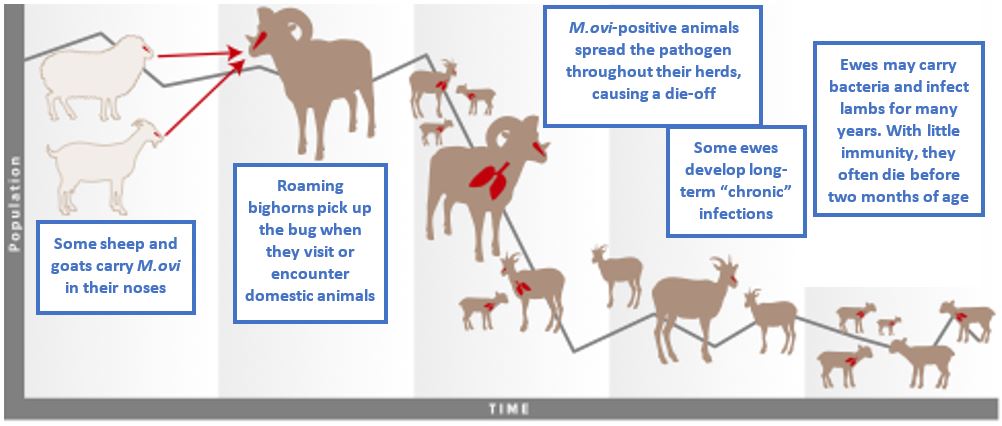Domestic and wild sheep and goats, and the risk of Mycoplasma ovipneumoniae

M. ovi in domestic sheep and goats
M. ovi bacteria can be classified into different strains. These strains are not all the same, and different animals can be infected with different strains, even within one flock or herd.
In experimental studies, M. ovi has been shown to slightly reduce weight gains in domestic sheep. There have been some instances of M. ovi causing significant clinical respiratory disease.
Domestic goats can carry M. ovi strains that can cause disease in wild sheep and goats. However, goats may pose a lower risk to wildlife than domestic sheep. Little is known about M. ovi in domestic goats.
Domestic and wild sheep and goats, and risk of Mycoplasma ovipneumoniae (PDF, 364KB)

How do I know if my sheep or goats carry M. ovi?
Testing for M. ovi
If you are concerned about M. ovi in your domestic sheep flock or goat herd, learning more about its impacts is the first step, followed closely by testing your animals. It is also recommended to discuss your concerns with your veterinarian. Please contact the Animal Health Centre for more information on obtaining and handling samples, as well as for advice on testing strategies tailored to your flock/herd.
Polymerase Chain Reaction (PCR) tests
- PCR tests look for genetic evidence that the organism is currently present. PCR tells us that the DNA of M. ovi was present on the sample tested. This usually is an indication of current infection but does not actually tell us if the bacteria are alive and replicating.
- Animals may shed this organism intermittently or in low numbers, so repeated testing is often needed to confirm that an individual animal is not infected.
- Work with your veterinarian and/or consult with the veterinarians at the Animal Health Centre for interpretation of testing and if repeated testing is needed.
How to submit a laboratory specimen
Collection and storage
Samples must be aseptically collected and kept refrigerated immediately after collection. Samples that cannot immediately be transported to the laboratory should be stored at 4°C for a maximum of two days, or frozen if they are going to be stored for longer.
Swabs for bacterial PCR tests
For nasal swabs use polyester swabs with a plastic shaft and avoid cotton and wood (these contain PCR inhibitors). Swabs can be obtained from your veterinarians. Swabs can be submitted in sterile saline or universal transport media (UTM) also available from your veterinarian. Swabs submitted in bacterial transport media are not suitable for PCR testing. Please contact your veterinarian and/or the Animal Health Centre if you have questions.
Services, fee schedule and submissions guide (PDF, 2MB)
How to keep your animals safe from wild sheep
Domestic and wild sheep share several infectious organisms, but their immune systems and tolerance of disease are very different. To prevent pneumonia, wild sheep and goats should be kept separate from their domestic cousins. Despite much research, there is currently no effective treatment or vaccine, but there are things you can do to help:
- Establish your flock or herd’s M. ovi status – M. ovi status is determined by testing nasal swabs from your animals. If your flock/herd is M. ovi free, make sure that they do not interact with other M. ovi positive flocks/herds. Follow appropriate biosecurity practices to protect your flock/herd, including pre-testing and quarantine of new arrivals.
- Know where wild herds are located – this will help you determine if your flock are at risk to interactions with their wild counterparts. Researchers have developed buffer zones surrounding the wild sheep and goat herds within British Columbia. See an interactive map of Bighorn and Thinhorn sheep ranges.

- Fence for safety: Fencing resources. Secure fencing is crucial to maintain separation from wild sheep and goats. A number of designs are available to help prevent contact with domestic sheep and goats
- Report – Call the Report All Poachers and Polluters (RAPP) line immediately if you see wild sheep or goats in an area that risks contact with domestic sheep or goats or vice versa.
Removing M. ovi from a group of domestic sheep or goats could benefit producers by improving lamb or kid weight gain, as well as overall herd health. There is currently no cure for M. ovi; however, research is underway to establish possible treatment protocols.
General resources for producers
Publications are available on health and nutrition of sheep and goats, including:
Keeping Flocks Healthy: Sheep and goats (PDF, 5.9MB), a guide for producers on biosecurity, common animal diseases and how to prevent and/or treat them.
The codes of practice, developed by the National Farm Animal Care Council, are guidelines for the care and handling of farm animals. They are an excellent source of practical information:
- Code of practice for the care and handling of sheep
- Code of practice for the care and handling of goats
Learning more about wild sheep and mountain goats
There are also resources available through wild sheep conservation organizations such as:
- The Wild Sheep Society of British Columbia
- The Western Association of Fish and Wildlife Agencies: Wild Sheep Working Group Initiative
